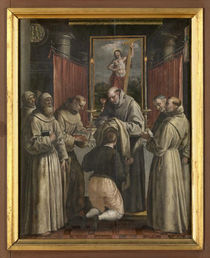The Catholic Defender: Saint Giles among the ‘Fourteen Holy Helpers’. In England,
- Donald Hartley

- Aug 31
- 2 min read
Updated: Sep 1
Deepertruth with special permission and aid with Franiciscan Media, a great team for the Lord

St Giles is the patron saint for disabled people, lepers, beggars and blacksmiths and his feast day is celebrated on the first of September.
Most artwork depicts him with is deer. The King's hunters, who had looked for a place of refuge for the night, finally discovered his solitude. The next day an arrow was shot at a deer, but instead wounded the saint, thus becoming the patron saint of handicap persons.
In medieval art, he is depicted with his symbol, the hind. His emblem is also an arrow.
Despite the fact that much about Saint Giles is shrouded in mystery, we can say that he was one of the most popular saints in the Middle Ages. Likely, he was born in the first half of the seventh century in southeastern France. That is where he built a monastery that became a popular stopping-off point for pilgrims making their way to Compostela in Spain, and the Holy Land.
In England, many ancient churches and hospitals were dedicated to Giles. One of the sections of the city of Brussels is named after him. In Germany, Giles was included among the so-called 14 Holy Helpers, a popular group of saints to whom people prayed, especially for recovery from disease, and for strength at the hour of death.
Also among the 14 were Saints Christopher, Barbara, and Blaise. Interestingly, Giles was the only non-martyr among them. Devotion to the “Holy Helpers” was especially strong in parts of Germany and in Hungary and Sweden. Such devotion made his popularity spread. Giles was soon invoked as the patron of the poor and the disabled.
The pilgrimage center that once drew so many fell into disrepair some centuries after Giles’ death.
He spend many years in solitude conversing only with God. The fame of his miracles became so great that his reputation spread throughout France. He was highly esteemed by the French king, but he could not be prevailed upon to forsake his solitude. He admitted several disciples, however, to share it with him. He founded a monastery, and established an excellent discipline therein. In succeeding ages it embraced the rule of St. Benedict. St. Giles died probably in the beginning of the eighth century, about the year 724.
Saint Giles may not have been a martyr but, as the word martyr means, he was a true witness to the faith. This is attested to by the faith of the People of God in the Middle Ages. He became one of the “holy helpers” and can still function in that role for us today.
Giles, to flee from the vanity and praise of this world, to avoid carefully all occasions of sin, to cleanse our hearts from all wickedness by a sincere Confession, to leave this world in Thy love and rich in good works, and to find Thee gracious on the day of judgment. Through Christ our Lord. Amen.





















Comments